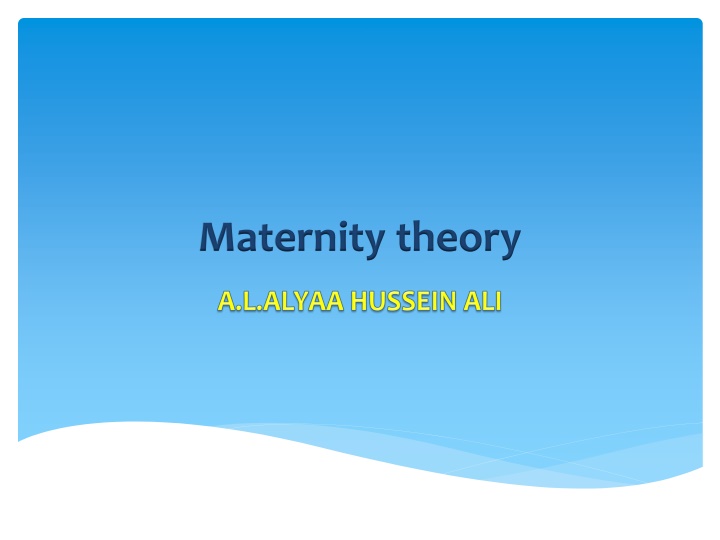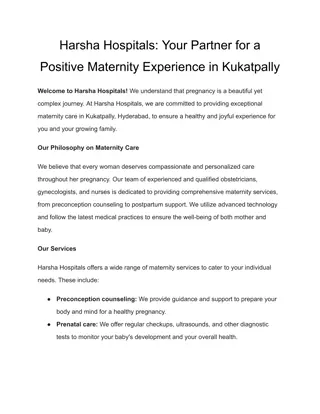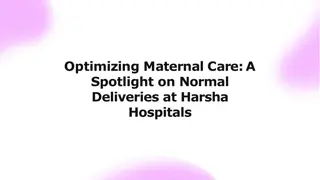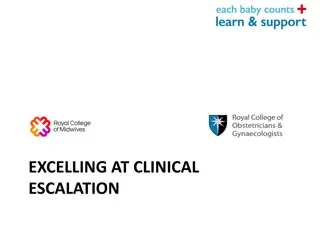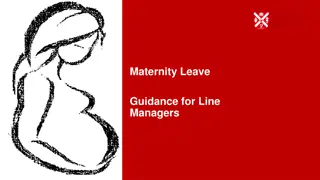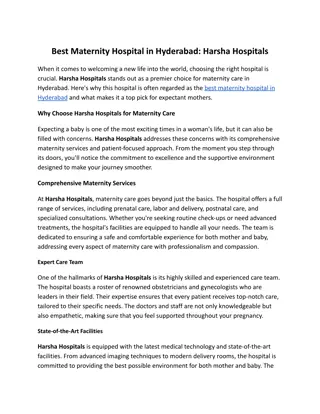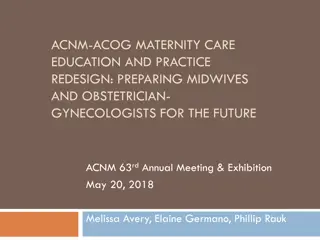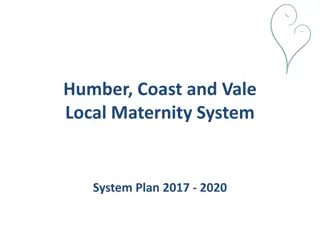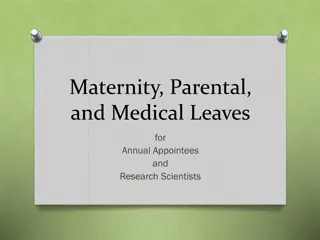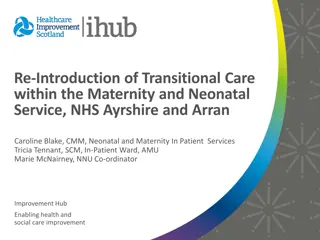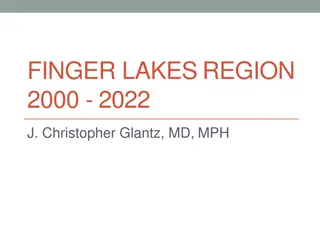Maternity theory
Prenatal care plays a crucial role in ensuring the health of both the mother and the developing fetus. This care involves regular monitoring, education, and addressing potential risks to promote a healthy pregnancy and delivery. Learn about the importance of prenatal care, its objectives, frequency of visits, and initial nursing assessments for expectant mothers. Discover key information on gestational age, fetal development monitoring, and valuable tips for maintaining a healthy pregnancy.
Download Presentation

Please find below an Image/Link to download the presentation.
The content on the website is provided AS IS for your information and personal use only. It may not be sold, licensed, or shared on other websites without obtaining consent from the author.If you encounter any issues during the download, it is possible that the publisher has removed the file from their server.
You are allowed to download the files provided on this website for personal or commercial use, subject to the condition that they are used lawfully. All files are the property of their respective owners.
The content on the website is provided AS IS for your information and personal use only. It may not be sold, licensed, or shared on other websites without obtaining consent from the author.
E N D
Presentation Transcript
Prenatal Care Prenatal care refers to the care that is given to an expected mother from time of conception is confirmed until the beginning of labor. Prenatal care has the potential to reduce the incidence of preterm birth and congenital anomalies and the infant mortality rate.
The purposes of prenatal care Establish a baseline of present health Determine gestational age Monitor fetal development Identify the woman at risk for complications Minimize the risk of possible complications Provide time for education, which will relieve fear and anxiety
Schedule of Prenatal Visits (low-risk pregnancy) Monthly until 28 weeks gestation. Biweekly (every 2 weeks) from 28 weeks until 36 weeks. Weekly from 36 weeks until delivery.
Nursing Care for Women During First (initial) Prenatal Visit Determine EDD based on LMP. Document current gestational age (gestational wheel is a tool for quick reference to current gestational age). Document baseline vital signs. Document height, weight, and body mass index (BMI). Auscultate fetal heart tones.
Measure fundal height in centimeters from symphysis pubis to the top of the fundus. Discuss procedure for lab testing Obtain urine specimen and blood sample. Provide appropriate education for gestational age
Education in the Early Prenatal Period Teratogens are substances that are harmful to the developing fetus; advise patient to avoid exposure. Nutrition, encourage daily prenatal vitamin with 400 _g folic acid Suggest 6 8 glasses of water daily.
Recommended weight gain depends on pre-pregnancy weight/BMI. Physical activity in pregnancy is recommended unless contraindicated by medical complications. Sex not restricted in pregnancy unless risk factors exist for bleeding or preterm labor. Elevated estrogen and progesterone levels in early pregnancy generate changes in the body, causing pregnancy associated discomforts.
No. 1 Discomfort Urinary frequency Patient Education Related to uterine position/weight Encourage frequent emptying of bladder Discourage limiting oral fluids Related to elevated hormone levels Encourage small, frequent meals Eat crackers before rising Avoid pungent odors, spicy or greasyfood Related to hormone changes Discuss normalcy of emotional changes with patient and 1 . 2 . 3. 1 . 2 . 3 . 4. 1 . 2 . partner 3. 2 Nausea and vomiting 3 Emotional lability Ambivalence normal in first trimester
1 . 2 . 3 . 4. 1 . 2 . 3 . 4 . 5 . 6. 1 . 2 . 3.Encourage naps during the day 4. Encourage prenatal vitamins 1.Related to vaso-congestion of mucous membranes 2.Increased humidity in home may help 3.Warm compresses to sinus area 4.Avoid over-the-counter (OTC) cold remedies Related to vasocongestion of mucous membranes Avoid tampon use and douching Wear peri-pad to absorb discharge Encourage cotton underwear Hormone-related breast development often first presumptive sign of pregnancy Wear a supportive bra Colostrum may be expressed in pregnancy Introduce the value of breastfeeding Introduce/reinforce breast self-exam Related to rapid hemodynamic and metabolic changes in the first trimester 4 Leucorrhea 5. Breast discomfort 6. 7 Fatigue Nasal stuffiness/ Epistaxis
No. Warning Sign Vaginal bleeding Possible Cause Abortion 2 . 3. 1 . 1 Placenta previa or Abruptio placenta Preterm labor 2 1 . Premature rupture of amniotic fluid 2 . Incontinence of urine Urinary tract infection Leakage of vaginal fluid Dysuria 3 4 Headache Pregnancy-induced hypertension (PIH) 5 Altered vision (Blurred vision Pregnancy-induced hypertension (PIH) 6 Abdominal cramping Preterm labor 7 Pregnancy-induced hypertension (PIH) Severe epigastric pain 8 Fetal demise Decreased fetal movement 9 Elevated temperature Infection 10 Persistent vomiting Hyperemesis gravidarum
Nursing Care for Return Prenatal Visits Measure pulse and blood pressure (BP) Compare BP to initial reading (measured in the same position at each visit) Measure weight and compare to last reading Note total weight gain Obtain urine specimen and test for protein and glucose Measure fundal height
Determine fetal position and perform Leopolds Maneuver Monitor fetal heart tones (FHT) Record presence of fetal movement Assess for presence of edema. Discuss procedure for diagnostic testing Provide patient education appropriate for gestational age
Education in the Return Prenatal Visits 1. Teach patient to count fetal movement and report change in fetal movement pattern to primary health-care provider 2. Discuss fetal growth and development 3. Demonstrate palpating for contractions 4. Discuss symptoms of preterm labor 5. Differentiate between true and false labor 6. Encourage childbirth preparation class 7. Discuss options for pain control in labor
Minor discomforts during late pregnancy (Second and Third Trimester)
Discomfort Patient Education 1 . Related to hormone changes in pregnancy; fade after pregnancy Changes in pigmentation Linea nigra (pigmented line from umbilicus to pubic bone) Chloasma (deeper facial pigment) Striae (stretch marks) Round ligament pain (occasional, sharp lower abdominal pain) 2.Moisturizers decrease itching, but will not prevent striae 1.Related to round ligament stretching as uterus grows. 2.Change positions slowly 3.Encourage good body mechanics 1.Instruct patient how to palpate Contractions 2.Labor should occur after 38 weeks 3.Teach patient to differentiate between true and false labor Braxton-Hicks contractions (false labor contractions)
1.Related to decreased venous return due to pressure of the gravid uterus 2.Rest in lateral recumbent position 3.Elevate legs when sitting 4.Drinks 6 8 glasses water daily 5 Ankle edema 1.Caused by increased venous stasis related to pressure from the uterus Varicose veins 2.Wear pregnancy support hose 3.Avoid lengthy standing 4.Change positions frequently 6 7 1.Related to increased pressure on abdominal organs and sphincter relaxation 2.Encourage small, frequent meals 3.Avoid spicy foods 4.Sit up after meals Heartburn 1.Related to shift in posture due to gravid uterus 8 Backache 2.Encourage low-heeled shoes
1.Related to upward diaphragmatic pressure exerted by the gravid uterus 2.Allow more time for strenuous 9. Shortness of breath activities 3.Eat small, frequent meals 4.Lightening will lessen symptoms 1.Related to fetal movement, nocturia 2.Teach relaxation techniques 10. Insomnia 3.Encourage side-lying with pillow supports 4.Warm milk/shower before sleep 1.Related to uterine pressure on the pelvic nerves or calcium imbalance 11 Leg cramps 2.Review daily calcium intake 3.Teach signs of deep vein thrombosis 1.Related to decreased gastric motility; iron supplement may worsen constipation 12. Constipation / Hemorrhoids 2.Increase dietary fiber and water intake 3.Encourage exercise 4.Discourage enemas and laxatives
Nursing Diagnosis Examples of nursing diagnoses involving the changes that occur with pregnancy are: 1.Anxiety related to unexpected pregnancy. 2.Altered breathing pattern related to respiratory system changes of pregnancy. 3.Disturbed body image related to weight gain with pregnancy. 4.Deficient knowledge related to normal changes of pregnancy. 5.Imbalanced nutrition, less than body requirements, related to early morning nausea.
6.Risk for ineffective coping related to confirmation of unplanned pregnancy. 7.Health-seeking behaviors related to guidelines for nutrition and activity during pregnancy. 8.Deficient knowledge regarding exposure to teratogens during pregnancy. 9.Risk for injury to fetus related to current lifestyle behaviors.
References: Holloway, B., Moredich,C., Aduddell,K. (2006). OB PedsNotes Women s health,Davis Company, Philadelphia, 19-51. Perry, S. E., Hockenberry, M. J., Lowdermilk, D. L., Wilson, D., Alden, K. R., & Cashion, M. C. (2018). Maternal child nursing care 6thedition. Mosby. 152-201. Perry,S.E., Hockenberry,M.J., Lowdermilk, D.L., Wilson,D. (2014). Maternal Child Nursing Care. 5thedition, Mosby, an imprint of Elsevier Inc., Canada, 169-224. Pillitteri, A. (2010). Maternal and Child health Nursing: Care of the Childbearing and Childrearing Family, 6thedition, Lippincott Williams & Wilkins, Philadelphia, 219-268.
